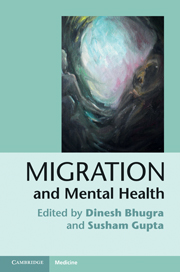Crossref Citations
This Book has been
cited by the following publications. This list is generated based on data provided by Crossref.
Lane, Pauline
Tribe, Rachel
and
Hui, Rosa
2011.
Intersectionality and the Mental Health of Elderly Chinese Women Living in the UK.
International Journal of Migration, Health and Social Care,
Vol. 6,
Issue. 4,
p.
34.
Guha, Martin
2012.
Encyclopedia of Immigrant Health.
Reference Reviews,
Vol. 26,
Issue. 8,
p.
38.
Smoleń, Agata
2013.
Health problems of Polish post-accession migrants. Implications for health care systems.
Problemy Zarzadzania,
Vol. 11,
Issue. 41,
p.
227.
Nirmala, BergaiParthsarathy
Kumar, Ashok
and
Virupaksha, HG
2014.
Migration and mental health: An interface.
Journal of Natural Science, Biology and Medicine,
Vol. 5,
Issue. 2,
p.
233.
Resera, Elena
Tribe, Rachel
and
Lane, Pauline
2015.
Interpreting in mental health, roles and dynamics in practice.
International Journal of Culture and Mental Health,
Vol. 8,
Issue. 2,
p.
192.
Schneider-Strawczynski, Sarah
2016.
The Psychosocial Health of Migrants and Refugees: A Review Essay.
SSRN Electronic Journal ,
Sharma, Sagar
2016.
Impact of Globalisation on Mental Health in Low- and Middle-income Countries.
Psychology and Developing Societies,
Vol. 28,
Issue. 2,
p.
251.
Bhugra, Dinesh
2016.
Mental health for nations.
International Review of Psychiatry,
Vol. 28,
Issue. 4,
p.
342.
Chtereva, Elena
Ward, Tony
and
Ramsey-Wade, Christine
2017.
Becoming ‘another brick in the wall’: A thematic analysis of Central and Eastern European immigrants’ experience of psychological distress and help-seeking.
Counselling Psychology Review,
Vol. 32,
Issue. 3,
p.
26.
Hosseini, Ashraf
Kakuma, Ritsuko
Ghazinour, Mehdi
Davern, Melanie
Evans, William. P.
and
Minas, Harry
2017.
Migration experience, resilience and depression: a study of Iranian immigrants living in Australia.
International Journal of Culture and Mental Health,
Vol. 10,
Issue. 1,
p.
108.
Tripathi, Adarsh
Garg, Kabir
and
Javed, Afzal
2019.
Advances in Psychiatry.
p.
577.
Hall, Brian J.
Garabiles, Melissa R.
and
Latkin, Carl A.
2019.
Work life, relationship, and policy determinants of health and well-being among Filipino domestic Workers in China: a qualitative study.
BMC Public Health,
Vol. 19,
Issue. 1,
Mas Giralt, Rosa
2019.
Bereavement from afar: transnational grieving and the emotional geographies of migration.
Children's Geographies,
Vol. 17,
Issue. 5,
p.
578.
Tribe, Rachel
2019.
Using co-production within mental health training when working with refugee or migrant community groups.
International Journal of Mental Health,
Vol. 48,
Issue. 4,
p.
330.
GHRAIRI, Mohammed
and
PEKER, Hüseyin
2020.
Türkiye’de Yaşayan Iraklı Göçmenlerin Deizm ve Ateizme Yönelik Tutumları.
IBAD Sosyal Bilimler Dergisi,
p.
513.
Bhogal, Ranjot
2020.
Punjabi Depression Inventory: A culturally sensitive measure for Punjabi-speaking migrants residing in the UK.
Counselling Psychology Review,
Vol. 35,
Issue. 2,
p.
22.
Bailey, Natalie Victoria
and
Tribe, Rachel
2021.
Mental Health, Mental Illness and Migration.
p.
1.
Bailey, Natalie Victoria
and
Tribe, Rachel
2021.
A qualitative study to explore the help-seeking views relating to depression among older Black Caribbean adults living in the UK.
International Review of Psychiatry,
Vol. 33,
Issue. 1-2,
p.
113.
Kirmayer, Laurence J.
Fung, Kenneth
Rousseau, Cécile
Lo, Hung Tat
Menzies, Peter
Guzder, Jaswant
Ganesan, Soma
Andermann, Lisa
and
McKenzie, Kwame
2021.
Guidelines for Training in Cultural Psychiatry.
The Canadian Journal of Psychiatry,
Vol. 66,
Issue. 2,
p.
195.
Bailey, Natalie Victoria
and
Tribe, Rachel
2021.
Mental Health, Mental Illness and Migration.
p.
369.



